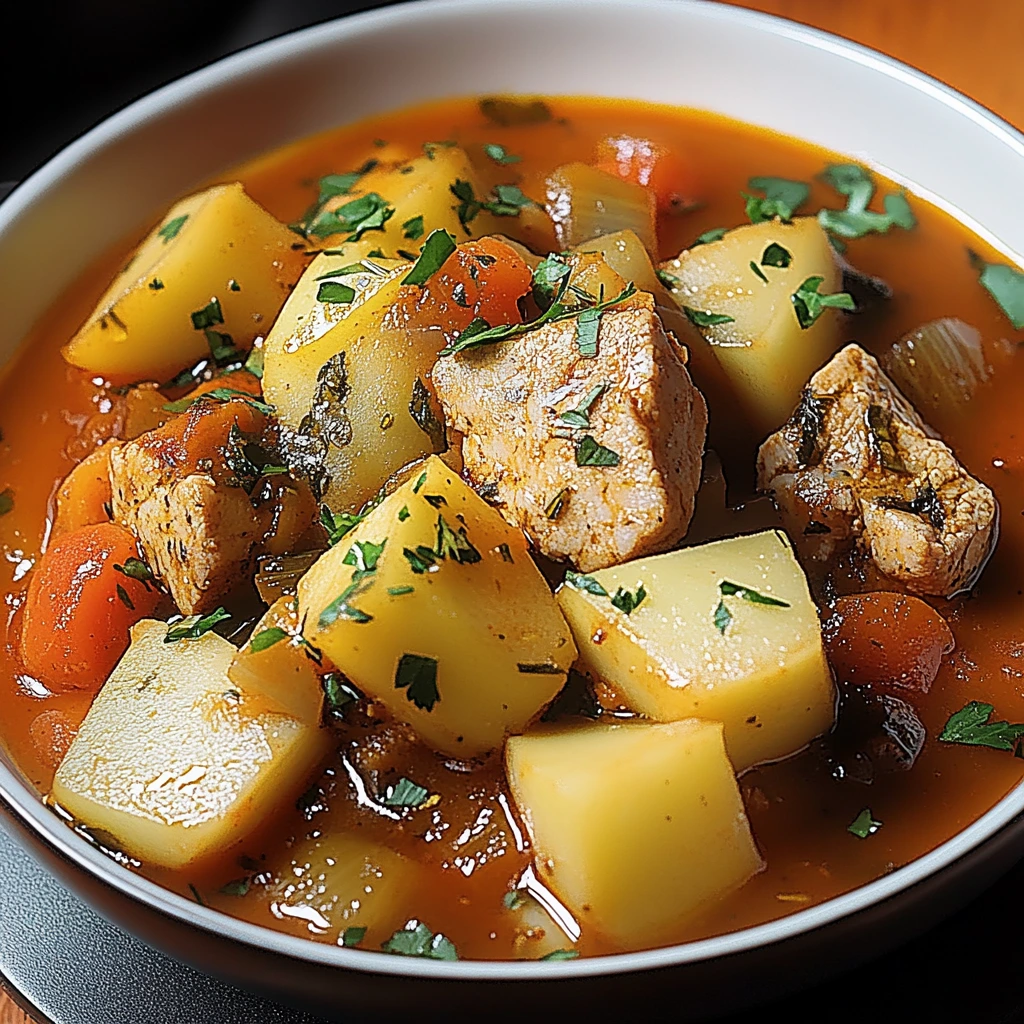 Pin it
Pin it
This traditional Basque tuna stew combines sea and land flavors in one comforting dish. The perfect harmony happens when fresh tuna meets potatoes and bell peppers, creating a truly Mediterranean taste experience.
I first tried Marmitako during a trip to Basque Country and I've been tweaking it ever since. It's become my family's go-to Sunday meal in fall when we want something filling but not too heavy.
Ingredients
- Extra virgin olive oil: key for a true flavor base, grab a good quality bottle for best results
- Onion: creates the aromatic foundation, pick a firm yellow or white one
- Fresh garlic: adds necessary depth, go for firm cloves without sprouts
- Green bell pepper: brings that slight bitterness typical in Basque stews, look for firm, shiny ones
- Red bell pepper: adds sweetness and nice color, choose a plump, ripe pepper
- Potatoes: they soak up all the goodness and add body, waxy varieties like Charlotte work best
- Fresh tomatoes: bring acidity and umami, pick ripe, fragrant ones
- Smoked paprika: gives that signature taste, Spanish pimentón works wonders
- Dried thyme: a Mediterranean herb perfect for slow-cooked dishes
- Fish stock: forms the liquid base, homemade will make the flavor pop
- Bay leaf: gently infuses during cooking, use an aromatic dried leaf
- Fresh tuna: the star of the show, go for quality cuts like fillets or steaks
Step by Step Instructions
- Creating the flavor base:
- Warm up olive oil in a big pot over medium heat. Make sure it's hot but not smoking to keep all its goodness. Toss in finely chopped onion and stir for 2 minutes until it turns see-through. Add minced garlic and cook for another minute, stirring non-stop so it doesn't burn. Put in the diced green and red peppers and cook about 5 minutes until they soften up but still have a bit of bite.
- Building flavors:
- Throw in grated or finely chopped tomatoes. You'll notice liquid starting to come out. Sprinkle in the smoked paprika for that signature color and taste. Add salt, black pepper, and dried thyme. Let everything cook for about 5 minutes until tomatoes break down into a thick sauce. All the flavors will start coming together nicely.
- Cooking the potatoes:
- Add potato chunks (about 2cm pieces) to the pot and stir to coat them in the tomato mix. Let them cook for 2 minutes to start soaking up flavors. Pour in just enough fish or vegetable stock to cover everything. Drop in the bay leaf and bring it all to a boil. Once it's bubbling, turn the heat down right away to medium-low for a gentle simmer.
- Simmering and finishing:
- Let it simmer uncovered for 20-25 minutes, giving it a stir now and then, until you can easily poke the potatoes with a knife tip. Keep an eye on the liquid and add more stock if needed. When potatoes are done, carefully place fresh tuna chunks into the pot. Push them slightly into the broth without stirring too much so they don't fall apart. Cook just 3-5 minutes until tuna is barely done in the center but still juicy and tender.
I think smoked paprika is the hidden gem that makes this dish special. The first time I made it for my Spanish in-laws, they couldn't believe how authentic it tasted. My mother-in-law even told me it was the best Marmitako she'd had outside of Basque Country.
Storage and Reheating
You can keep this stew in the fridge for 2-3 days in a sealed container. The flavors actually get stronger and better over time, so it's perfect for making ahead. When you want to warm it up, do it slowly on low heat, adding a splash of water or stock if it's thickened up. Don't overheat the tuna or it'll dry out and lose its tenderness.
Regional Variations
Some parts of Basque Country add Espelette pepper for a gentle kick of heat. In coastal villages, they sometimes throw in shellfish like mussels or clams along with the tuna. In San Sebastian, some chefs splash in a bit of txakoli, a slightly fizzy local white wine, to deglaze the veggies and add a tangy note to the dish.
 Pin it
Pin it
Perfect Pairings
Marmitako usually stands alone as a complete meal, but a crusty country loaf works wonders for soaking up that tasty broth. A simple green salad with just olive oil and sherry vinegar brings a nice fresh touch. For the real deal, pair it with a chilled glass of txakoli or a dry white wine from the Rioja region.
Frequently Asked Questions
- → Where does this tuna stew come from?
This hearty dish is from Basque cooking, traditionally made by fishermen on their boats.
- → What tuna is best for this stew?
Fresh tuna like albacore or white tuna works best for authentic flavor and tender texture.
- → Can I switch tuna for another fish?
Sure! Firm fish like cod or salmon can be excellent alternatives based on your taste.
- → Is this dish okay to make ahead?
You can prep the stew base early, but it’s best to add the tuna last to keep it perfectly cooked.
- → What pairs well with this stew?
It stands alone as a main dish, though fresh bread or a light salad can round it out nicely.
